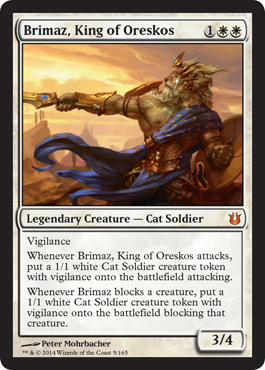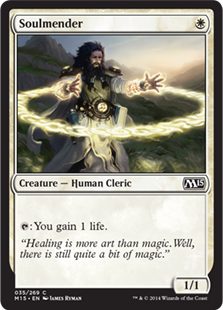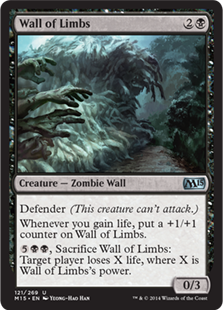By now most of us are familiar with M15 – I’ve done a few drafts and attempted to put some new decks together – and are looking to build new decks and generally look towards the future, especially in terms of Standard.
So, the one burning question – what’s happening to removal?
True, effective removal seems to be going out of its key colours, such as Black, and into secondary colours, such as Red and White. I want to take a quick look at each of these colours to see where the most effective answers lie. Note, that this will also include board wipes as any removal that can act as a 2-for-1 or better is clearly going to be worthwhile to many players.
On the other hand, I’m not going to look at Blue and Green. Blue has often had bounce spells and tempo effects which, while they work very well, aren’t exactly removal. In any case, I don’t think Blue has a problem and Green, similarly, has always revolved around creatures. While the current options in M15 are expensive – where’s my one drop fight spell? – it still depends on having the right creatures.
Anyway let’s go…
Black
If Black is good at anything, it’s death. If you don’t like something, there should be a spell open to you as an answer. For years, Doomblade has been the answer in trade, and we’ve had various variants of the two-drop death spell, most notably in Return to Ravnica (Ultimate Price) and Journey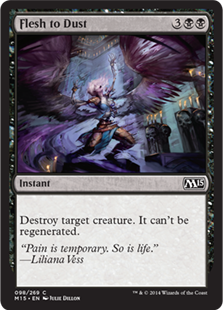 Into Nyx (Feast of Dreams). If that doesn’t work, we have more complete answers and Theros’s Heroes Downfall can kill almost anything, including Planeswalkers.
Into Nyx (Feast of Dreams). If that doesn’t work, we have more complete answers and Theros’s Heroes Downfall can kill almost anything, including Planeswalkers.
…so what do we do with Flesh to Dust? While preventing regeneration is good… this is a 5 mana spell. Instant speed is a nice bonus, but it’s still a big drop down from Downfall. We’ve gone from 3 mana to five and the only benefit is the regeneration clause, yet we also lose the ability to kill Planeswalkers.
Okay, we’re comparing a common card to rare, but there aren’t any rare targeted kill spells in M15. This is the core set’s standard answer for creatures and, even then, it’s a big change to Ultimate Price, Feat of Dreams and co.
We also have a few -X/-X effects, but these have seldom been competitive and are often staple hole fillers in limited (removal is still removal). Ulcerate, for instance, is fantastic at -3/-3, since it can effectively work like a black lightning bolt, but it does hurt you as well. Similarly we have Stab Wound and while I love the card I’m not sure it will be enough for standard.
There’s also Covenant of Blood, which is one of Black’s convoke spells. 4 damage, in addition to the life gain, is a good spell but 7 mana means you’re going to need a few convoke creatures on the board to make this anywhere near playable.
Black Board Wipes
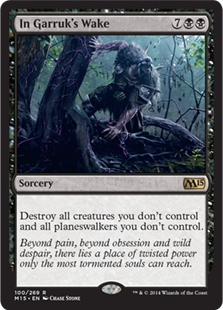 Admittedly, black doesn’t always get a board wipe spell – often it gets a black-white option in gold sets – so it’s not something we can as easily complain about. Garruk’s Wake is certainly an effective card but it does cost 9 mana. It’s easy to see why, too. In Garruk’s Wake destroys creatures and planeswalkers your opponents control, giving you full board control.
Admittedly, black doesn’t always get a board wipe spell – often it gets a black-white option in gold sets – so it’s not something we can as easily complain about. Garruk’s Wake is certainly an effective card but it does cost 9 mana. It’s easy to see why, too. In Garruk’s Wake destroys creatures and planeswalkers your opponents control, giving you full board control.
The only problem with this however is, again, the 9 mana. This suggests a late game strategy which locks this deck out of quicker mono-black decks or aggro decks. If esper takes off in Standard I could see this getting included more but 9 mana spells are always trouble, especially against Blue. Even then, you have to consider the answers your opponent might have, such as being able to save some key creatures.
Red
Red ‘removal’ has always been a difficult option, since it’s not the only thing it can do. Anything that can do damage to both creature and player is very effective and this is where Red often has a little trade off. A card may do more damage, but for the same mana it will often only target creatures of planeswalkers, but usually not both.
do damage to both creature and player is very effective and this is where Red often has a little trade off. A card may do more damage, but for the same mana it will often only target creatures of planeswalkers, but usually not both.
Similarly, we’re use to the likes of Fated Conflagration. For 4 mana, it can deal 5 damage to a creature or planeswalker at instant speed. In most instances, this will remove the target in question so, while it costs a whole mana more, this could arguably be seen as Red’s equivalent to a hero’s downfall. Red doesn’t get guaranteed ‘destroy creature’ effects so cards like Fated Conflagration are often better than they look – assuming you’re not running Black in the first place.
Likewise, even the commons have proven strong and this has continued in M15. 2 mana for 3  damage at instant speed is often worth while and the reprint of Lightning Strike keeps everyone happy.
damage at instant speed is often worth while and the reprint of Lightning Strike keeps everyone happy.
However, I have already spoken somewhat on Stoke the Flames, but the card is quickly growing on me. 4 damage is something we need and this card can be cast for cheaper and it can target players (and thus, planeswalkers). Until Born of the Gods rotates, we have an interesting trade-off: do you run Fated Conflagration for the extra damage, or stay with Stoke the Flames for the option of burning the opponent out of the game.
Additionally, there could be room for Cone of Flame, since it can remove 3 targets and has proven very versatile, or even Heat Ray for when you need to deal more than 5 damage, although I fin Cone of Flame to be much more powerful than Heat Ray. Pure mono-Red decks might also be interested in Seismic Strike, as it can deal 3 damage or more, especially in the late game.
In short: of all the colours, Red is as strong as ever.
Red Board Wipes
M15 doesn’t have any board wipes for Red, but then it’s a colour that arguably gets them even less than Black. The problem for many Red 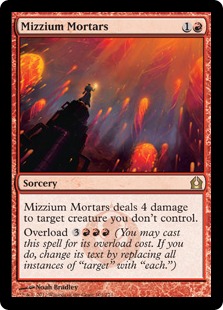 players, myself included, is that we’ve had some good options in the last two blocks. Anger of the Gods dealt damage to your own creatures, but it was an effective way to wipe the board – plus, if you were going to run it you’d plan around it. 3 damage across the board, plus exile effects, makes for a very strong card.
players, myself included, is that we’ve had some good options in the last two blocks. Anger of the Gods dealt damage to your own creatures, but it was an effective way to wipe the board – plus, if you were going to run it you’d plan around it. 3 damage across the board, plus exile effects, makes for a very strong card.
Similarly, in Return to Ravnica we had Mizzium Mortars. This cost 2 to use as a simple spell or 6 to overload, dealing 4 damage to every creature that wasn’t your own. Mortars was a strong card and I imagine we won’t see such a strong answer for a while. While Red might be losing these options, it has enough burn to pick up the slack – if you need to target more than one creature (such as Triplicate Spirits) then Cone of Flame can serve you well.
White
If you have 3 or 4 mana, some of which is at least White, you really don’t need to worry about other creatures.
 In other words, White has some effective solutions. The weakest of which, Divine Verdict, is still a strong card in a limited vacuum. Its other options, however, are much more versatile at 3 mana. Depending on how the meta game goes, I could see this going either way.
In other words, White has some effective solutions. The weakest of which, Divine Verdict, is still a strong card in a limited vacuum. Its other options, however, are much more versatile at 3 mana. Depending on how the meta game goes, I could see this going either way.
First of all – the card I think more likely to find its way into competitive, constructed decks, is Devouring Light. For 3 mana, you can exile an attacking or blocking creature. This already makes it multitudes better than Divine Verdict: it’s a mana cheaper and removes the creature for good. Its also got Convoke, so you could play it even earlier. If there are any aggressive early drops, especially in Black since it likes to bring things back from the graveyard, this exile effect could prove to be very, very powerful.
On the other hand, if big creature decks such as Jund and Naya take over than Pillar of Light could see it’s way into some fringe play. It’s 3 mana – the same as Devouring Light but without the Convoke option – and exiles any creature with toughness 4 or more. That beats most Hydras, Brimaz, any big demon or dragon. The list goes on – in the right match ups, why would you not sideboard this in?
These are effective answers and are stronger than what we’re use to. To compare it to a recent set, Theros had Glare of Heresy, which was very restrictive, and Vanquish the Foul, which was 6 mana for a sorcery speed spell.
White Board Wipes
If there’s one colour that gets to wipe the board, it’s White. Most players have, at some point, had to face down the likes of Wrath of God and remove all their creatures. This is a little too good but even recent core sets have the like of Planar Cleansing. If you splash a little Blue, you also have the likes of Return to Ravnica’s Supreme Verdict; a card that has shaped and dominated the meta game because it was that powerful.
 However, when Theros block hit the scene we saw a slight step away from these effective spells. Born of the Gods gave us Fated Retribution, which cost 7 mana. Granted, it was an instant speed spell that also removed Planeswalkers, but it was 7 mana. Likewise, M15 now gives us Mass Calcify, which is another 7 mana spell.
However, when Theros block hit the scene we saw a slight step away from these effective spells. Born of the Gods gave us Fated Retribution, which cost 7 mana. Granted, it was an instant speed spell that also removed Planeswalkers, but it was 7 mana. Likewise, M15 now gives us Mass Calcify, which is another 7 mana spell.
Worse, this one isn’t even instant speed, but it could do you some favours. It only destroys creatures which aren’t White, which clearly pushes it into a mono-White strategy, or something that only plays White creatures.
This puts it in the same area of Garruk’s Wake as a 7 mana card that stands to benefit you in the right decks and strategies. Yet, are these the strategies that want a 7 mana removal spell? White and Black can be both be evasive. More so, while Black has deathtouch, White has first strike and a bunch of exile spells to help it survive in combat.
The Final Verdict
I’m not entirely sure what’s going on, but there are clearly some changes at work. White, for instance, is trading its effective removal for slightly more clunky wipe effects and powerful common and uncommon exile spells. Black – the king of removal – has the clunky 7 drop but has only gotten worse in terms of removal.
Red, on the other hand, is still awesome and as a Red player this suits me just fine, but I do like to play Boros and Rakdos, where part of the charm was the additional spells I could gain access too.
Hopefully, Khans of Tarkir will provide some more effective spells, but since the first set is a gold block, I expect these spells won’t fit into mono-colour strategies.
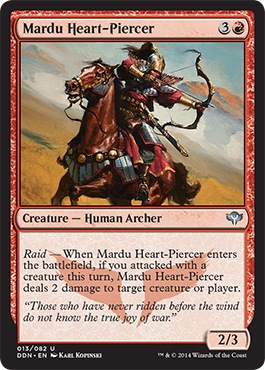
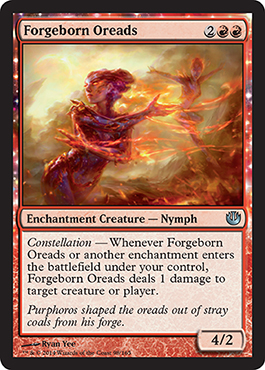

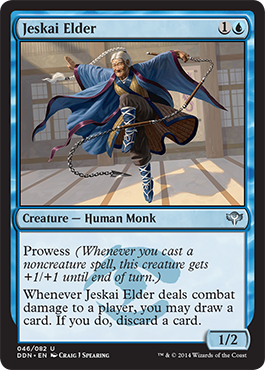
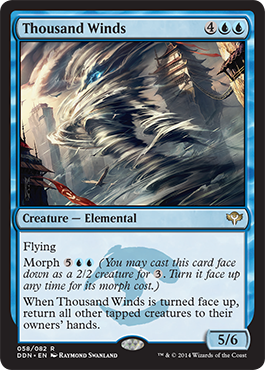
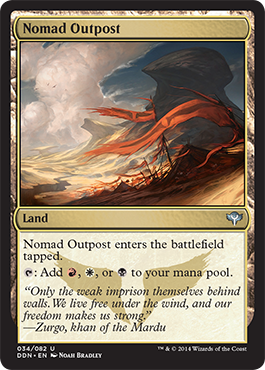
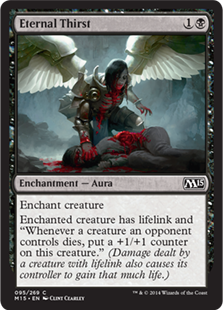
 that it’s an enchantment means it can be taken away easily and many opponents will have planned answers for auras. As a result, we should look for a deck where it will be a big benefit if it sticks around but, even if it doesn’t, can it offer any incremental advantage?
that it’s an enchantment means it can be taken away easily and many opponents will have planned answers for auras. As a result, we should look for a deck where it will be a big benefit if it sticks around but, even if it doesn’t, can it offer any incremental advantage?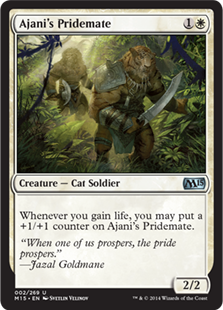 In short, there are options.
In short, there are options. Into Nyx (Feast of Dreams). If that doesn’t work, we have more complete answers and Theros’s Heroes Downfall can kill almost anything, including Planeswalkers.
Into Nyx (Feast of Dreams). If that doesn’t work, we have more complete answers and Theros’s Heroes Downfall can kill almost anything, including Planeswalkers.


 players, myself included, is that we’ve had some good options in the last two blocks. Anger of the Gods dealt damage to your own creatures, but it was an effective way to wipe the board – plus, if you were going to run it you’d plan around it. 3 damage across the board, plus exile effects, makes for a very strong card.
players, myself included, is that we’ve had some good options in the last two blocks. Anger of the Gods dealt damage to your own creatures, but it was an effective way to wipe the board – plus, if you were going to run it you’d plan around it. 3 damage across the board, plus exile effects, makes for a very strong card. In other words, White has some effective solutions. The weakest of which, Divine Verdict, is still a strong card in a limited vacuum. Its other options, however, are much more versatile at 3 mana. Depending on how the meta game goes, I could see this going either way.
In other words, White has some effective solutions. The weakest of which, Divine Verdict, is still a strong card in a limited vacuum. Its other options, however, are much more versatile at 3 mana. Depending on how the meta game goes, I could see this going either way.

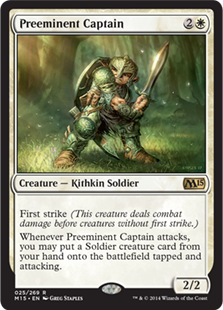



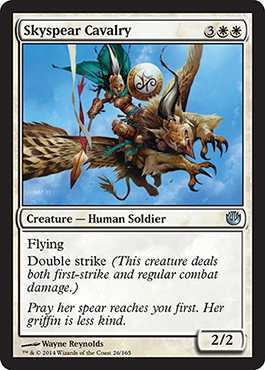

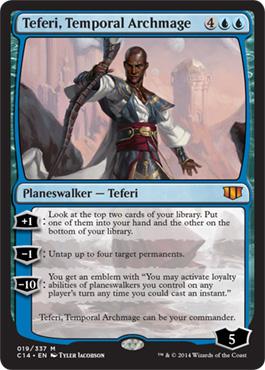

 Similarly, when the following small-set comes out – currently codenamed “Dewey” – is released, that will be added to the front of the draft for a Dewey/Khans/Khans format. Simple so far.
Similarly, when the following small-set comes out – currently codenamed “Dewey” – is released, that will be added to the front of the draft for a Dewey/Khans/Khans format. Simple so far. These represent the five clans on the plane of Tarkir. Interestingly, however, is the fact that the wider Khans block will not be focused on wedges: I suspect this is part of the ‘time travel’ storyline.
These represent the five clans on the plane of Tarkir. Interestingly, however, is the fact that the wider Khans block will not be focused on wedges: I suspect this is part of the ‘time travel’ storyline.


